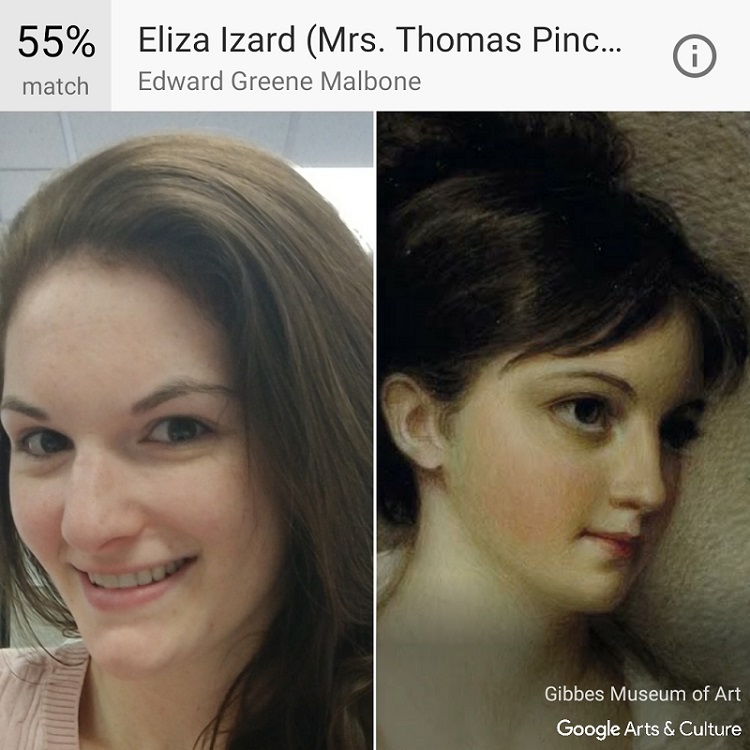
Bring the history of picture frames and artwork to life with this educational craft activity using paper frames. This is a great project to combine with the new popular Google app called Arts & Culture. Students can use the app to discover which museum portrait they match with, then draw their portrait inside the frames!
Age Group: 7 and up
Project Time: 30 minutes
Materials:
- Cardstock frame designs
- Metallic markers
- Colored pencils
Create a Framed Portrait – Using Google App
Instructions:
- Students will go to the Arts & Culture app by Google, and scroll to the “Search with your selfie” section. Click Get Started, then take a selfie. You can then scroll through the different portraits at the top that come up as a lookalike match.
- Each student will choose their favorite portrait, then click on the photo to learn more about it. Have them write down the title and some information about the portrait from the app.
- Share the images to your email and print them out. Have each student draw or print and paste their own portrait inside one of the 4 frame designs. You can have them draw right from the device if each student has their own classroom tablet.
- Decorate the frame with the included colored pencils and markers.
- Cut out the frame using the dotted line as a guide.


Variation for younger age groups: If you are working with a younger group of students and drawing the portraits is too advanced, print the portraits and glue them to the inside of the frames.
Student Art Gallery
Now you can use the finished artwork in your classroom. Create a Student Art Gallery with the finished frames and hang them all together on a wall or bulletin board. You can choose to feature a student’s artwork each month, and create a lesson on that particular artist or painting. This is a great interactive way to feature new artwork in your classroom.
If you are not using the app for this project, you can simply use the frames to feature a students’ artwork. These frames are great for any age group. Students can draw their own portrait, a favorite pet, or relate it to the topic you are learning about.

Educational Discussion
Once each student has finished their frame, have a discussion about the different types of portraits and artwork. Below is some information to guide your lesson:
Frames have existed since the 2nd century B.C. when borders were found drawn around Etruscan cave paintings. The frame may have started out as a form of protection, but its visual and symbolic purposes soon became equally important. The frame separates the work of art from its surroundings and may help focus the viewer’s attention. At the same time, it can actually unite a work with its surroundings by forming a transition or a link to other works or to the wider setting. The frame can become part of the setting itself when it is designed to fit into an architectural scheme. The frame is also intended to enhance a picture visually.
As long as people have made art, there have been portraits. A traditional portrait is a painting, drawing, sculpture or a photograph of a person. The purpose of a portrait is to show the likeness, essence, personality, and even the mood of the person. For the first few thousand years at least, portraits, whether drawn, painted or sculpted, were mostly reserved for those deemed important enough to be honored with a work of art bearing their likeness. The wealthy – mostly royalty and nobility – and important religious and historic figures were the most common subjects.
Baroque & Rococo Styles
In the 17th Century, oil painting portraiture became the art form of choice for the wealthy. The frame in which these valuable portraits were displayed quickly became equally as important. By the time of the Baroque period following the Italian Renaissance, some painters had also begun to take an interest in portraits of the common man. The wealthy soon began to focus on embellishing the portrait frames with excessive valuables as a reflection of their status and power. You can see in Europe and the Near East, frames of Baroque and later on Rococo styling took a backward step and were emblazoned in gold leaf or inlaid with gold motifs and other valuable gemstones.
The Baroque style is still popular today, not only in regards to frame design but general modern day décor across the world. As you create your portrait and decorate its frame, reflect on the characteristics listed below that define the Baroque and Rococo art movements to help inspire your modern creation. For further inspiration research the works of famous 17th Century artists Rembrandt (Baroque) and Caravaggio (Rococo).
Baroque
- Dramatic Light
- High Contrast
- Emotionally Saturated
- Sensuous Richness
- Exaggerated Motion
- Exuberant
- Realistic Detail
- Bold Ornamentation
- Heroic
- Symmetrical
Rococo
- Whimsical
- Playful
- Ornate
- Elegant Curves
- Luxurious
- Light-Hearted
- Hyper-Embellished
- Exuberant
- Idyllic
- Asymmetrical
Artist Statements
An Artist Statement is essentially a short statement about a piece of artwork or body of art – the “who, what, where, when and why.” It can be as detailed or as basic as each artist chooses it to be. Print the included labels and have each artist fill it out including a statement about their work.
Artist Labels (printable PDF)

More Fun Facts
- The earliest known frame originated in the 2nd century AD, where a Fayum mummy
portrait was discovered in an Egyptian tomb surrounded by a decorative wooden frame. - The early American frames are very spare and utilitarian. Towards the mid 1800’s frames can be distinguished by agricultural symbols that were used to decorate the frames like tobacco, corn and wheat.
- There are no copyrights held on frame designs so many frames today are produced to look like earlier designs.







